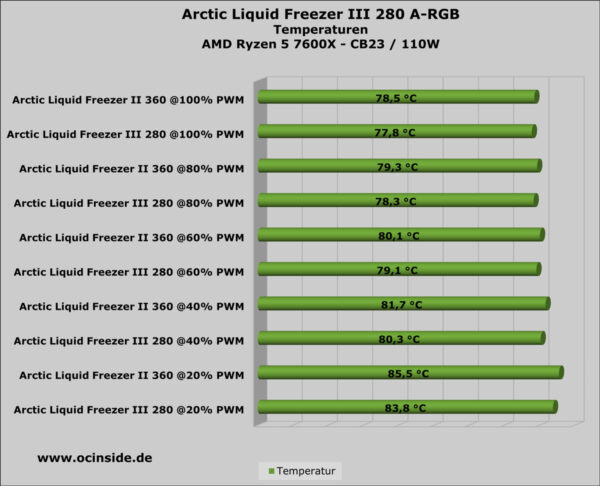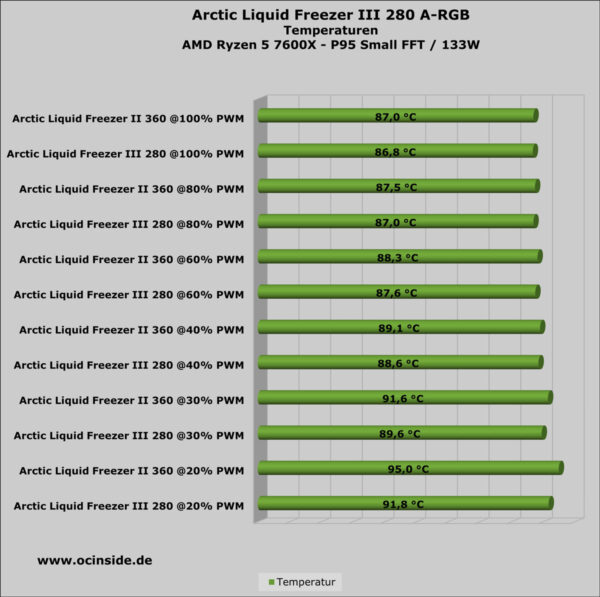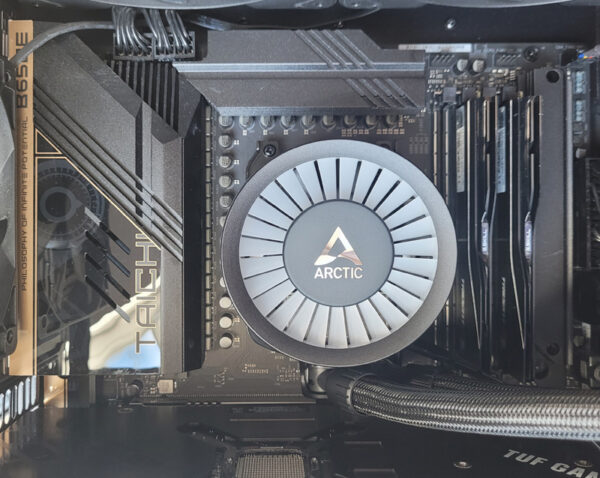
Test setup and results …
To test the Liquid Freezer III 280 A-RGB Black, we use our AMD AM5 test system, which consists of the following components.
| Motherboard | ASRock B650E Taichi |
| SSD | Crucial T700 1TB M.2 PCIe 5.0 NVMe SSD CT1000T700SSD3 |
| CPU | AMD Ryzen 5 7600X |
| RAM | 2x 16GB DDR5-6400 |
| PSU | Seasonic Vertex GX-850 |
| Graphics card | AMD Radeon RX6800XT |
| Case | Fractal Design North |
| Operating system | Windows 11 – Version 23H2 |
For the following performance test of the Arctic Liquid Freezer III 280 ARGB, we alternately load the AMD Ryzen 7600X processor with the Cinebench R23 benchmark and the extremely demanding Prime95 Small FFT test. As a comparison, we use the widely used predecessor Arctic Liquid Freezer II 360, whereby the LF III 280 has approx. 91% of the cooling surface of the LF II 360. As the noise level of the pump is negligible for both competitors, we always run the pump at 100% for both coolers and only regulate the speed of the radiator fans.
Temperatures Cinebench R23 …
Arctic Liquid Freezer II 360 vs. Liquid Freezer III 280 with Cinebench R23. In the first test, the coolers have to dissipate approx. 110W from the AMD Ryzen 7600X processor, which, as expected, is not a particularly big challenge for either candidate. Even at 20% PWM, where the Liquid Freezer III 280 is barely audible, it has no problems cooling the CPU sufficiently. At 100% PWM it is just 0.7°C ahead of the LF II 360 and at 20% PWM it can outperform its predecessor by 1.7°C thanks to the larger fans and despite the slightly smaller radiator.

Temperatures Prime95 Small FFT …
Arctic Liquid Freezer II 360 vs. Liquid Freezer III 280 with Prime95 Small FFT. Prime95 makes every CPU sweat with the Small FFT test, because this test runs in the processor’s cache so that no data has to be reloaded from the RAM, which puts maximum load on the CPU with the AVX code. In this case, the Ryzen 7600X processor even consumes 133W, which the cooler has to cope with. But even in this endurance test, the new Liquid Freezer III 280 can hold its own against the LF II 360. Even though the temperature difference at full fan speed is insignificant, the LF III 280 just manages to keep the CPU from reaching its thermal limit at 91.8°C even at 20% fan speed. The LF II 360, on the other hand, needs at least 30% fan control so that the CPU is not throttled due to excessive temperatures.

Temperature conclusion …
In summary, it can be said that under normal operating conditions, there is very little difference between cooling a Ryzen 5 7600X with a Liquid Freezer III 280 or a Liquid Freezer II 360, with the LF III 280 coming out slightly ahead. Due to the larger fans, the LF III 280 can outperform the LF II 360 somewhat more clearly in our test at low fan speeds. This makes the Arctic Liquid Freezer III 280 a particularly good choice if you want to cool your PC quietly!
VRM Fan …
The significantly larger VRM fan of the Liquid Freezer III generates an equally significantly increased airflow to the voltage converters (VRM) on the mainboard, which provide the power for the processor. In tight spaces and especially when using a CPU water cooler without a VRM fan, the necessary airflow over the heat sinks of the VRMs can be restricted, causing their temperature to rise. The VRM fan of the Liquid Freezer III is designed precisely to provide the voltage converters with the necessary airflow that would otherwise be generated by a CPU air cooler. Thanks to its ingenious design, it does this particularly evenly in all directions except downwards towards the graphics card.
Volume …
Audible noises are mainly generated by the radiator fans, as the VRM fan and the pump are practically inaudible from a closed PC case as soon as a single case fan is active. The P14 PWM PST A-RGB fans on the radiator of the Liquid Freezer III 280 A-RGB, which have been available separately or on other coolers from Arctic for some time, are good acquaintances in the OCinside.de test editorial team. They work pleasantly unobtrusively on the thick radiator up to 80% PWM and do not produce any unpleasant whistling or vibration noises. The last 20% from 1500 rpm then significantly increase the noise level and hardly provide any additional cooling capacity, so this speed range does not necessarily have to be used. We were able to determine a maximum of 41dBA when operating 2 fans at full speed. The distance of the measuring microphone was an extremely small 30cm. With our AMD Ryzen 5 7600X processor, the Liquid Freezer III 280 can easily cope with even the lowest fan speeds and only produces a quiet whisper.
Arctic Liquid Freezer III Lighting …


